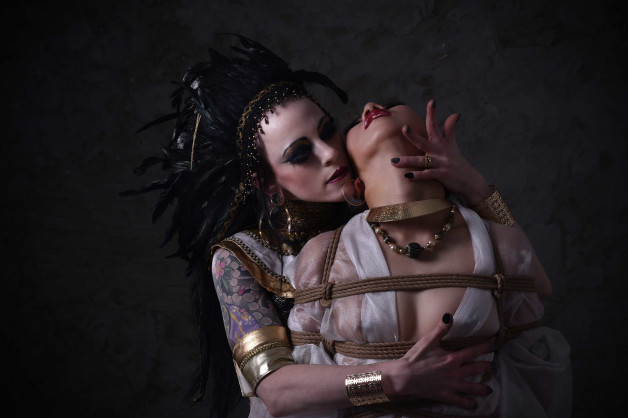30 stunning full colour photos
Milla Reika’s photo-book ‘The Descent of Inanna’ is now available. This is her first photo-book, featuring 30 full color photographs of her recent stage performance, ‘An Adaption of The Descent of Inanna’, is now on sale for a limited time at 4000 yen (free shipping), which is about $36 or £27.50.
As you will have seen from my earlier post, Milla has been a great influence on Osaka Dan who authored some tutorials for us on ShibariClasses. You might have been lucky enough to catch her performing at Torture Garden a few months back. Her shows are well worth watching as she is not only an excellent kinbakushi but also a true performer who creates an feast for the senses. This book conveys that wonderfully showing the real beauty of kinbaku.
Milla does not merely turn Kinbaku into ‘rope-art’ but rather embeds Kinbaku within a theatrical narrative that explores and expresses deeper concepts and intricacies of human relations and desires. Ying-Yang and Buddhist principles of dependent origination ー “if this exists, that exists; if this ceases to exist, that also ceases to exist” ー are key themes that run through her performances, alongside explorations of the dualistic notions of the self and of the ‘other’.
The story behind the performance
An Interpretation of ‘The Descent of Inanna’
The Descent of Inanna emerged from the literary corpus of Mesopotamia circa 4000 BC. Inscribed upon clay tablets, the story follows Inanna, goddess of sexual love, fertility and war, and her visit to the queen of the underworld – and her sister – Ereshkigal.
Ereshkigal is the neglected side of Inanna; that part of Inanna that was unloving and unloved, abandoned, instinctual, and full of rage, greed, and desperate loneliness. She ruthlessly destroys all that goes against our true individuality or appropriate life path. She does not lead us to our goal by revealing what it is but rather by eliminating everything that it is not.
Inanna arrives at the outer gate of the underworld in all her glory, wearing the garments of her power and light, wishing to enter. Resplendent, Ereshkigal perceives her as full of ambition, pride and the desire to expand her influence. Yet, perhaps Inanna is merely looking for that other, darker side of herself she’s long neglected, seeking to become whole. Regardless of Innana’s motive, Ereshkigal is enraged by her appearance and orders the seven gates to be bolted. Inanna is allowed to pass only one gate at a time, but before each gate she must remove a piece of her royal garb.
When Inanna finally reaches the throne room of Ereshkigal she is naked and stripped of all her heavenly powers. Ereshkigal passes her eye of judgment on Inanna and condemns her to death. She kills Inanna.
Yet, faced with what she has done, Ereshkigal is overcome with intense pain and suffering, for Inanna was the other side of herself.
The Enki, servants of the queen of the underworld, plead with her to release her personal anguish, her despair and anger, which is embodied in the glorious Goddess of Love. They ask for the rotting body of Inanna.
When Ereshkigal agrees to release her nemesis, and thus part of her pain, the Enki sprinkle the food and water of life on Inanna’s corpse.
And Inanna arises…
A co-production by Milla Reika (Senkaku productions) & Feline (Eroticfreestyle). Directed and written by Milla Reika

